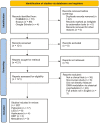Default Mode Network Modulation by Psychedelics: A Systematic Review
- PMID: 36272145
- PMCID: PMC10032309
- DOI: 10.1093/ijnp/pyac074
Default Mode Network Modulation by Psychedelics: A Systematic Review
Abstract
Psychedelics are a unique class of drug that commonly produce vivid hallucinations as well as profound psychological and mystical experiences. A grouping of interconnected brain regions characterized by increased temporal coherence at rest have been termed the Default Mode Network (DMN). The DMN has been the focus of numerous studies assessing its role in self-referencing, mind wandering, and autobiographical memories. Altered connectivity in the DMN has been associated with a range of neuropsychiatric conditions such as depression, anxiety, post-traumatic stress disorder, attention deficit hyperactive disorder, schizophrenia, and obsessive-compulsive disorder. To date, several studies have investigated how psychedelics modulate this network, but no comprehensive review, to our knowledge, has critically evaluated how major classical psychedelic agents-lysergic acid diethylamide, psilocybin, and ayahuasca-modulate the DMN. Here we present a systematic review of the knowledge base. Across psychedelics there is consistent acute disruption in resting state connectivity within the DMN and increased functional connectivity between canonical resting-state networks. Various models have been proposed to explain the cognitive mechanisms of psychedelics, and in one model DMN modulation is a central axiom. Although the DMN is consistently implicated in psychedelic studies, it is unclear how central the DMN is to the therapeutic potential of classical psychedelic agents. This article aims to provide the field with a comprehensive overview that can propel future research in such a way as to elucidate the neurocognitive mechanisms of psychedelics.
Keywords: DMN; LSD; Psychedelics; ayahuasca; connectivity; psilocybin.
© The Author(s) 2022. Published by Oxford University Press on behalf of CINP.
Figures



References
-
- Aday JS, Mitzkovitz CM, Bloesch EK, Davoli CC, Davis AK (2020) Long-term effects of psychedelic drugs: a systematic review. Neurosci Biobehav Rev 113:179–189. - PubMed
-
- Aghajanian GK, Marek GJ (1999) Serotonin-glutamate interactions: a new target for antipsychotic drugs. Neuropsychopharmacol. 6:122–133.
-
- Aleksandrova LR, Phillips AG (2021) Neuroplasticity as a convergent mechanism of ketamine and classical psychedelics. TIPS 11:929–942. - PubMed
Publication types
MeSH terms
Substances
LinkOut - more resources
Full Text Sources

